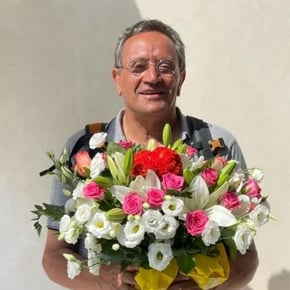"The Wall of Sound," the latest creation by panGenerator, a group of artists founded in Warsaw, transforms the human voice into a unique artistic experience. The interactive installation allows the public to create music by recording their own voices using microphones arranged in a geometric network. This polyphonic work of art is a reflection of our rhizomatic and chaotic world, and it demonstrates the power of democratic creativity in art.
panGenerator is an interdisciplinary group founded in Warsaw in 2010 by Piotr Barszczewski (no longer a member), Krzysztof Cybulski, Krzysztof Goliński and Jakub Koźniewki. They are characterised by their use of mediums ranging from the visual arts to music, with which they create art that is a melding of different disciplines, techniques and technologies, from natural modes of expression, such as the human voice, to traditional and digital techniques.
Art that is “with all” for all
It is the union of all of these strengths that caught our attention (that of IBSA Foundation and of the National Museum of Science and Technology) for the series Digital Aesthetics. Something else worth noting is the fact that the group’s name is composed of two parts: “pan” and “generator”, combined into a word whose first letter, which would normally be capitalised (in other words, “PanGenerator”), is written in lower case. The same is true of the Italian group we introduced last year, who answer to the name “aurora Meccanica” (“Mechanical dawn”).
In the case of panGenerator, the name as it is written is reminiscent of a musical movement, rendered graphically: crescendo and calando, a movement that conveys the feeling of panic generated by sound.
The truth is, the term “pan” has many meanings, one of the first being that it refers to the rural god Pan, lover of dance and of music, and therefore related to Dionysus. As a matter of fact, since the time of ancient Greece, there has been a wind instrument, made of pipes of cane or reed, that is named after him: the Pan flute, or panpipes.
However, when it is used as a prefix instead of a stand-alone noun, “pan” also takes on the meaning of panic, terror, as is the case, for example, in that least pleasant instance, where “pan” is associated with our health in the word “pandemic”.
“Pandemic” comes from the Greek “pandémios”, meaning “of all the people”, where “pan” = “all” and “dēmos” = “populace”. It signifies a contagion event that progresses from the individual to the whole, a “total societal event”, on whose existential reconfiguration electronic media has had an important influence. In the case of panGenerator, it is clear that the name contains not only the above meanings, but also takes on the “quasi-divine” significance of generator of all, of art created using almost everything and for everyone.
Contributing to the artwork
It is a well-established fact that modern art, beginning with Futurism, long ago broke the barriers separating the different disciplines. What is perhaps less well known are the many new branches that have grown to enrich it as a result, including its contemporary digital adaptations, as demonstrated by the works of panGenerator. As is often the case with artists who work either totally or partially using digital technologies, we must not forget to underscore the way in which digital art brings with it a relationship with the end-user, who not only enjoys it, but also participates in the work’s co-creation—which is, for that matter, another of the requirements of Digital Aesthetics, and panGenerator is no exception to the rule.
So what makes this Polish collective exceptional?
To tell the truth, there is much about them that intrigues us, from the fact that they work as a group and not individually, as the romanticised solitary artist might, but instead continue to push the theme of sharing and of resilience as essential elements in the struggle to overcome the problems of contemporary life, including those that have arisen from the pandemic. Their art aids us in coming to grips with our daily digital rituals, which none of us can avoid any longer, thus helping us to use electronic media in a way that is creative as opposed to anxious and anaesthetised. The list of characteristics could go on and on, but allow us instead to take the approach of presenting the artwork chosen for Digital Aesthetics this year: The Wall of Sound (A collaborative sampler/sequencer in public space).
The Wall of Sound
It is a grid-like installation, a sort of spiderweb or geometric rhizome, with the potential to expand to infinity—indeed, to “all”—a trait which means it can be endlessly modified and installed anywhere, and thus be new each time. It was conceived in 2019, in the midst of the pandemic, in response to a commission by Katowice Street Art: Urban Sound, as an interactive installation where the public creates music by speaking and/or singing—in other words, by recording their voices using the electronic microphones located on the nodes of this “digital spiderweb”. The rhizomatic structure allows for the first sounds to be enhanced and diversified in the successive nodes, creating a polyphony of new voices and sequences as they progress.
It is an artwork consisting of total and collective sound, an auditory Tower of Babel, wherein each module is independent but without a control centre—and therefore anti-hierarchical and able to operate ad infinitum in relation to the others.
“Pandémios”: of all the people, and therefore of democratic creativity.
It is the aesthetic consequence of our rhizomatic and chaotic world, made up of a thousand strata, as the French philosophers Deleuze and Guattari explained years ago, warning us that: “When a rhizome is blocked, transformed into a tree, that is the end, nothing more of desire passes through it, because it is always through the rhizome that desire moves and is produced,” including for us, the rhizome of the art of panGenerator. Let us add ourselves.
By Giacinto Di Pietrantonio

